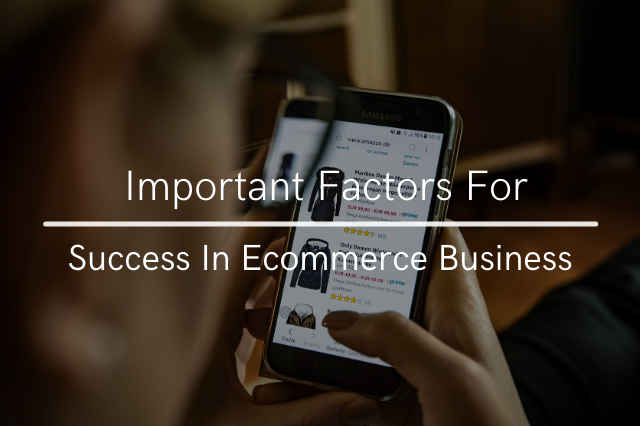7 Important And Powerful Factors For Success In Ecommerce Business.

In today’s highly digitalized world, everyone is turning toward online shopping, so if you’re thinking about starting an eCommerce business, now is a perfect time. However, while coming up with an idea and building a site is relatively easy, the competition is extremely fierce, and very few businesses survive their first year. In this article, I will tell you about 7 Important Factors For eCommerce Success that you can easily consider while making your eCommerce site.
There are many factors that can influence the success of an eCommerce store. How your business is marketed and branded can make or break your eCommerce company. In this article, we are offering 7 tips you should keep in mind when starting an eCommerce business. By applying some of today’s best practices for eCommerce and attention to detail, your e-store can see the success you desire.
1. Start With A Good Domain Name
Choosing a domain for your eCommerce site is one of the most important business decisions you will make. It is the first thing related to your brand that users will see and it will serve as a symbolic placeholder for your business in their minds.
When coming up with ideas for domain names, you can sit around and wait for inspiration to strike – you need to get proactive and conduct thorough research.
Of course, the process itself can be tedious as good domain names are usually already taken. Searching for the perfect domain name for your eCommerce business manually can take time and effort, but luckily, there are lots of places to buy cheap domain names. We recommend using an efficient domain name provider to speed things up.
2. Make Sure Your Web Design Is Simple And Clean
Did you know that nearly 50% of consumers determine whether a business is credible by its web design?
When it comes to designing your e-store, stay away from cluttered layouts and instead, go for a minimalistic design with elegant typography and simple colors. In addition, avoid using any elements that might distract your customers from the primary purpose of the site – buying your products.
A minimalistic design not only looks better but also loads quicker, which can help you improve engagement and decrease bounce rates.
3. Improve Your Site Navigation
After you’ve put so much effort into bringing visitors to your online store, you need to make sure you have a site that guides those visitors toward making a purchase. Good site navigation can help improve UX and result in more sales. Poor and complicated navigation, on the other hand, can annoy visitors and make them leave your site.
Your site navigation should help customers find what they’re looking for without too much fuss.
Follow navigation and design best practices to make things easier for shoppers. For instance, you should place your main menu on the left side or at the top of the page.
You should also organize your products into meaningful categories and subcategories, and include a search bar on every page to help users find what they are looking for instantly.
4. Be Mobile-Friendly
As technology continues to advance, businesses of all industries and sizes need to improve their mobile experience, especially those in the eCommerce sector. Mobile usage continues to grow every year, and with the predictions of mobile commerce sales projected to reach nearly 55% of digital sales on a global level in 2021, it is in your best interest to keep up with the industry.
With more people browsing on mobile devices than desktop, having an eCommerce site that is optimized for mobile opens a world of possibilities. More people will see your store, which means that you are going to get more customers and make more sales.
Responsive design can make your online store more user-friendly. Your mobile website should allow customers to easily access all of the important features, products, and offers in no time.
5. High-Quality Images
Unlike in physical stores, online shoppers can’t touch or feel your products. Product images play the role of a shop assistant – if they’re high-quality and attractive, customers are more likely to continue browsing your site.
For this reason, you shouldn’t hesitate to invest in good-quality product photos that show your products in the best light possible. More than 30% of online shoppers prefer to see several images before they make a purchasing decision, so make sure to show your products from multiple angles.
You could also include videos and 360-degree shots that show off all the product features, as well as photos of your product being used in real life to help customers establish an emotional connection.

6. Create Informative Product Descriptions
Strategic, well-written product descriptions can be the difference between a conversion and an abandoned shopping cart. While you may save time by copying generic descriptions provided by the manufacturers, it can have a negative impact on your bottom line.
A good product description describes a product’s features and benefits, acknowledges the problem it solves and declares why it is the best product for the job.
7. Deliver An Outstanding Checkout Experience
Use a clean and simple design to deliver a simple checkout process with features such as easy form-filling, guest checkout, persistent cart, and various payment options.
Finally, make sure shoppers feel more secure. Minimizing the risks related to online shopping will increase trust and encourage shoppers to follow through with their purchases. You could do that by adding payment logos and security seals, as well as offering a free refund option or money-back guarantee.
Final Thoughts
An eCommerce site should look great but also provide a superior shopping experience. If shoppers feel comfortable on your site, they will be more likely to make purchases and come back for more.
Incorporating these 7 components will help you improve the UX, boost engagement, and encourage visitors to purchase your products.
Use these 7 factors For Your eCommerce Success and see the magic results.
